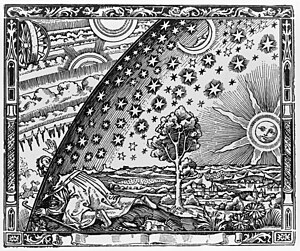
The Flammarion engraving is a wood engraving by an unknown artist. Its first documented appearance is in the book L'atmosphère : météorologie populaire ("The Atmosphere: Popular Meteorology"), published in 1888 by the French astronomer and writer Camille Flammarion.[1][2] Several authors during the 20th century considered it to be either a Medieval or Renaissance artwork, but the current consensus is that it is a 19th century illustration that imitates older artistic styles and themes.[1]
The illustration depicts a man, dressed as a pilgrim in a long robe and carrying a walking stick, who has reached a point where the flat Earth meets the firmament. The pilgrim kneels down and passes his head, shoulders, right arm, and the top of the walking stick through an opening in the firmament, which is depicted as covered on the inside by the stars, Sun, and Moon. Behind the sky, the pilgrim finds a marvelous realm of circling clouds, fires and suns. One of the elements of the cosmic machinery resembles traditional pictorial representations of the "wheel in the middle of a wheel" described in the visions of the Hebrew prophet Ezekiel.[1]
The wood engraving has often, but erroneously, been referred to as a woodcut.[1] It has been widely used as a metaphorical illustration of either the scientific or the mystical quests for knowledge.[1][3] More recently, it has also been used as to represent a psychedelic experience.[4]
- ^ a b c d e Gattei, Stefano (2014). "An Original Fake: Closing the Debate on Flammarion's Engraving". In Beretta, Marco; Conforti, Maria (eds.). Fakes!?: Hoaxes, Counterfeits, and Deception in Early Modern Science. Sagamore Beach: Science History Publications/USA. p. 206–265. ISBN 978-0881354959.
- ^ Flammarion, Camille (1888). L'atmosphère: météorologie populaire. Paris: Hachette. p. 163. The text is also available here Archived 2011-05-12 at the Wayback Machine.
- ^ Browne, Laurence (2021). "The Flammarion Engraving and its Symbolic Potential". Psychological Perspectives. 64 (4): 562–580. doi:10.1080/00332925.2021.2044173.
- ^ https://www.psychologytoday.com/intl/blog/the-athletes-way/201904/one-mystical-psychedelic-trip-can-trigger-lifelong-benefits